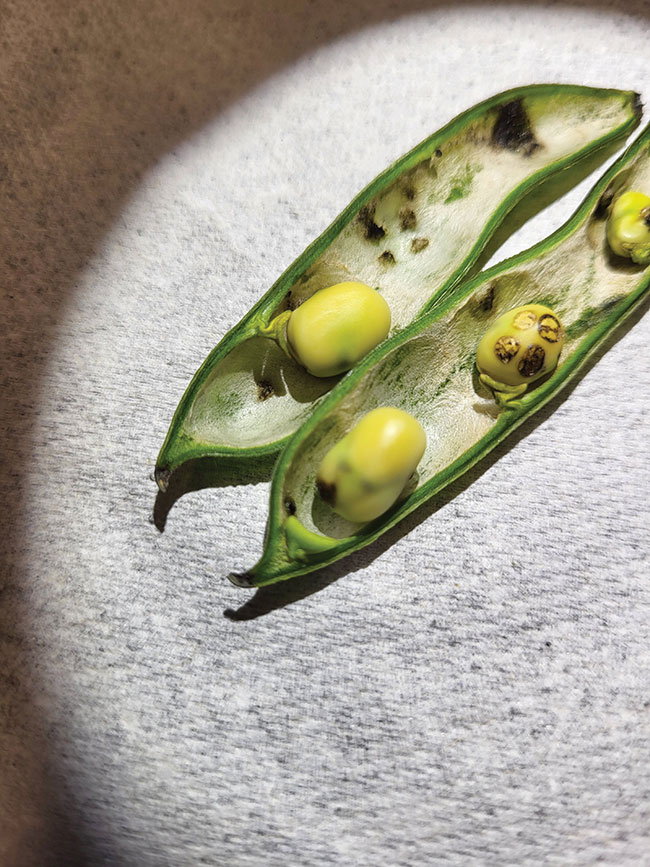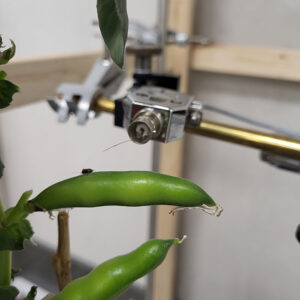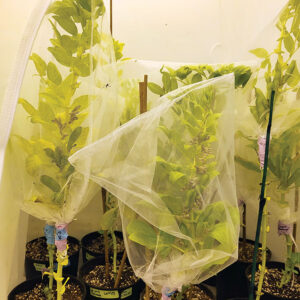
Features
Pulses
Managing lygus in faba bean
New tools under development for mitigating damage and reducing economic impacts.
February 28, 2024 By Donna Fleury
 Damage from lygus bugs visible in the seeds inside the pods after the no-choice chamber experiments.
ALL PhotoS courtesy of Teresa Aguiar Cordero, University of Saskatchewan.
Damage from lygus bugs visible in the seeds inside the pods after the no-choice chamber experiments.
ALL PhotoS courtesy of Teresa Aguiar Cordero, University of Saskatchewan. For faba bean growers, lygus bug is a problem pest that can quickly cause economic damage and downgrading even at small numbers. Researchers are trying to address knowledge gaps specific to lygus in faba bean crops and investigate potential strategies and tools for mitigating damage and reducing economic impacts.
“In our Lab, we specialize in insect ecology and integrated management for a range of pests and beneficial insects, including lygus,” says Sean Prager, associate professor and principal investigator of the Prager Lab at the University of Saskatchewan. “Lygus is a pest of various crops but is particularly a concern for faba bean because it is a later-season crop and often the only green crop around after canola and other crops have been harvested. Lygus tend to move into faba bean during the podding stages, feeding directly on the pods. The market for human consumption has very low tolerance for seed damage, with faba bean samples that have greater than one per cent perforated damage downgraded to Number 2 Canada. This can reduce the price of faba bean by as much as $3/bushel, resulting in significant economic losses.”
Annual field surveys were first initiated in 2017 to help identify the incidence and severity of lygus infestations and seasonal variability. Crops were sampled at the early podding stage across the faba bean growing areas across Saskatchewan by lab researchers in collaboration with the Ministry of Agriculture, Crop Insurance and the Saskatchewan Pulse Growers. The samples were sent to Prager’s Lab for identification and analysis. The field surveys continue, and new research projects are building on this information and knowledge.
In Prager’s Lab, graduate student Teresa Aguiar Cordero is conducting different experiments to learn more about the damage and economic impact of lygus bug feeding on faba bean. In the first experiments, under controlled chamber conditions, a series of no-choice bioassays were conducted to quantify the relationship between lygus bug numbers and the resulting damage to faba bean pods. Different species of lygus were put in controlled chambers at different levels, starting with one and gradually increasing numbers, for different amounts of time.
“The objective of this experiment was to provide an estimate of how many lygus feeding on faba bean pods and for how long before economic damage and downgrading occurs,” explains Prager. “This information is expected to indicate how severe the damage is at different levels and when to take action, as well as potentially provide a method of determining economic thresholds. Although the results are very preliminary, it appears that economic damage happens very quickly, and even at one or two lygus for as little as one day of feeding may be enough to cause downgrading.”
In the next experiment, the objectives were to understand the feeding behavior of lygus bugs in faba bean and determine how long it takes to cause seed damage. When lygus bug adults and nymphs feed on pods, they also inject digestive enzymes into the pods and developing seeds. These enzymes cause visible damage, leaving behind dark-coloured perforations in the seed.
“In this experiment, we used an electrical penetration graph (EPG) technique to gain a better understanding of the feeding behavior of lygus bugs in faba beans,” says Prager. “It is a complicated method but can provide information on precise feeding patterns of lygus bugs. Our preliminary results suggest this is happening much faster than we thought and likely too quickly to be able to take action. It appears that if you see one lygus, damage may have already occurred. This really changes the strategy for developing economic thresholds and becomes a slightly different problem to solve. We didn’t anticipate the damage to be this severe this quickly. Therefore, we are trying to develop other tools and management options.”
Controlling lygus with insecticides in faba bean is difficult because usually there are both flowers and pods on the plants when the lygus are in the field. Faba bean relies on pollinators, so growers must be careful when selecting an insecticide. Another consideration is pre-harvest intervals for insecticides, which may be challenging with the later infestations of this longer season crop. Therefore, trying to control lygus in adjacent crops may be another option.
“We are collaborating with research scientist Hector Carcamo at the Agriculture and Agri-Food Research Station in Lethbridge to try to determine where the lygus are coming from,” explains Prager. “We suspect lygus comes from canola or other crops, and after they are harvested the lygus move to faba bean as the next green food source. We want to know if we could predict the level of lygus infestation expected in faba bean based on what is in neighbouring crops. And would it be possible to control lygus in neighbouring crops and reduce populations enough, so they don’t move into the faba bean crop.”
Researchers are investigating the potential of trap crops as another possibility to reduce populations of lygus before they can move into faba beans. To do that, additional experiments are being conducted to determine the preferences of lygus when given a choice of different crop and plant species. The objective is to identify potential trap crops that could attract lygus populations as part of a management program to reduce the impact of lygus bugs on faba bean crops.
“The research is tricky because it requires doing experiments with multiple plants in a controlled environment that all need to be at the appropriate stage relevant to faba bean for testing,” says Prager. “Some crops such as faba bean don’t grow that well in the greenhouse, so it is challenging to get the crops to be at the right stages at the same time. We are testing various crops such as alfalfa and others and trying to find which crops lygus prefer. We know lygus does like alfalfa, but we don’t yet know whether they like it enough to be the best trap crop. These experiments are just getting underway, so we don’t have any results yet.”
“We are continuing our research to find better-integrated management options for lygus in faba bean crops,” adds Prager. “For faba bean growers who know they have a lot of lygus in neighbouring canola or alfalfa, trying to keep the crops as far apart as possible is recommended. Also considering a trap crop where lygus can more easily be controlled with insecticides may be an option. We are making progress towards better information and understanding potential management tools to minimize damage and decrease economic losses for growers.”

